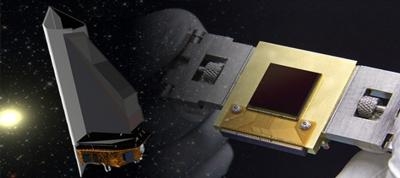Thu, Apr 18, 2013
NEOCam Designed To Track Near Earth Objects That Could Threaten The Planet
An infrared sensor that could improve NASA's future detecting and tracking of asteroids and comets has passed a critical design test. The test assessed performance of the Near Earth Object Camera (NEOCam) in an environment that mimicked the temperatures and pressures of deep space. NEOCam is the cornerstone instrument for a proposed new space-based asteroid-hunting telescope. Details of the sensor's design and capabilities are published in an upcoming edition of the Journal of Optical Engineering.

The sensor could be a vital component to inform plans for the agency's recently announced initiative to develop the first-ever mission to identify, capture and relocate an asteroid closer to Earth for future exploration by astronauts. "This sensor represents one of many investments made by NASA's Discovery Program and its Astrophysics Research and Analysis Program in innovative technologies to significantly improve future missions designed to protect Earth from potentially hazardous asteroids," said Lindley Johnson, program executive for NASA's Near-Earth Object Program Office in Washington, D.C.
Near-Earth objects are asteroids and comets with orbits that come within 28 million miles of Earth's path around the sun. Asteroids do not emit visible light; they reflect it. Depending on how reflective an object is, a small, light-colored space rock can look the same as a big, dark one. As a result, data collected with optical telescopes using visible light can be deceiving. "Infrared sensors are a powerful tool for discovering, cataloging and understanding the asteroid population," said Amy Mainzer, a co-author of the paper and principal investigator for NASA's NEOWISE mission at the agency's Jet Propulsion Laboratory in Pasadena, Calif. NEOWISE stands for Near-Earth Object Wide-Field Infrared Survey Explorer. "When you observe a space rock with infrared, you are seeing its thermal emissions, which can better define the asteroid's size, as well as tell you something about composition."

The NEOCam sensor is designed to be more reliable and significantly lighter in weight for launching aboard space-based telescopes. Once launched, the proposed telescope would be located about four times the distance between Earth and the moon, where NEOCam could observe the comings and goings of NEOs every day without the impediments of cloud cover and daylight. The sensor is the culmination of almost 10 years of scientific collaboration between JPL; the University of Rochester, which facilitated the test; and Teledyne Imaging Sensors of Camarillo, CA, which developed the sensor. "We were delighted to see in this generation of detectors a vast improvement in sensitivity compared with previous generations," said the paper's lead author, Craig McMurtry of the University of Rochester.
NASA's NEOWISE is an enhancement of the Wide-field Infrared Survey Explorer, or WISE, mission that launched in December 2009. WISE scanned the entire celestial sky in infrared light twice. It captured more than 2.7 million images of objects in space, ranging from faraway galaxies to asteroids and comets close to Earth. NEOWISE completed its survey of small bodies, asteroids and comets, in our solar system. The mission's discoveries of previously unknown objects include 21 comets, more than 34,000 asteroids in the main belt between Mars and Jupiter, and 134 near-Earth objects.
(image provided by NASA)
More News
Airport Rotating Beacon A visual NAVAID operated at many airports. At civil airports, alternating white and green flashes indicate the location of the airport. At military airports>[...]
Aero Linx: Fly for the Culture Fly For the Culture, Inc. is a 501(c)(3) non-profit organization that serves young people interested in pursuing professions in the aviation industry>[...]
Klyde Is Having Some Issues Comprehending The Fed's Priorities FMI: www.klydemorris.com>[...]
Also: Viasat-uAvionix, UL94 Fuel Investigation, AF Materiel Command, NTSB Safety Alert Norges Luftsportforbund chose Aura Aero's little 2-seater in electric trim for their next gli>[...]
Also: EP Systems' Battery, Boeing SAF, Repeat TBM 960 Order, Japan Coast Guard H225 Buy Despite nearly 100 complaints totaling millions of dollars of potential fraud, combined with>[...]
 ANN's Daily Aero-Term (04.25.24): Airport Rotating Beacon
ANN's Daily Aero-Term (04.25.24): Airport Rotating Beacon ANN's Daily Aero-Linx (04.25.24)
ANN's Daily Aero-Linx (04.25.24) Klyde Morris (04.22.24)
Klyde Morris (04.22.24) Airborne 04.24.24: INTEGRAL E, Elixir USA, M700 RVSM
Airborne 04.24.24: INTEGRAL E, Elixir USA, M700 RVSM Airborne 04.22.24: Rotor X Worsens, Airport Fees 4 FNB?, USMC Drone Pilot
Airborne 04.22.24: Rotor X Worsens, Airport Fees 4 FNB?, USMC Drone Pilot




